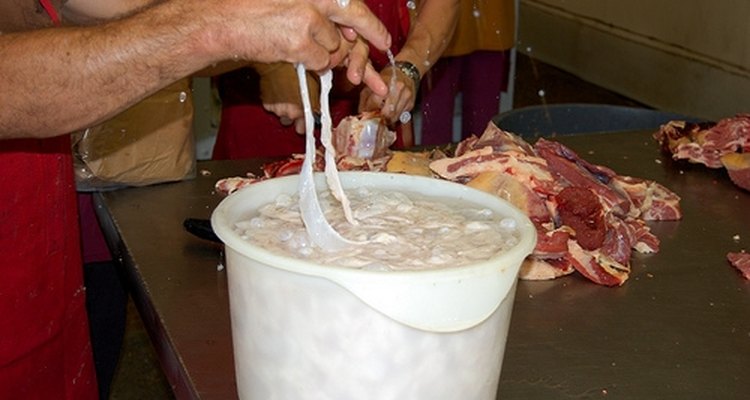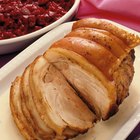
Making your own sausages can be rewarding, not to mention fun. Choosing the right type of sausage casing for your sausage-making needs doesn't have to be difficult; you just need to have the facts about different casing materials in front of you. That way, you can make an informed--and hopefully delicious--decision.
Types
Within the broader categories of natural and artificial casings, there are subcategories as well. Natural casing options are made mostly from the intestines of hogs and sheep. Some variations are made from hog stomachs and parts of beef intestines, as well.
Collagen casings are made from cowhides and have been chemically processed and extruded to form an edible protein wrapper.
Fibrous casings are made from paper mixed with cellulose. Unlike the other types of casings, fibrous casings are not edible. Rather, they are used while your sausages are smoking or otherwise curing and then removed before eating (see References 1, 2).
Pros and Cons of Natural Casings
Natural casings allow a deep, even penetration of any smoking process you put your sausages through. They're completely edible, have a good texture when you bite into your finished sausages, and they don't sully your sausages' flavor with their own. When properly stored, they can last for up to two years in your refrigerator.
However, natural casings can start to smell bad if not properly looked after. That doesn't mean that your natural casings should be thrown out. Usually, it just means that some gas has built up inside them. Airing them out might help. If it doesn't, rinse and re-soak them in salt water, possibly with a little baking soda dissolved in the water. They also have a tendency to break more easily than collagen or fibrous casings, so you'll need to be careful when stuffing them (see References 1, 2, 3).
Pros and Cons of Collagen Casings
Collagen cases are very strong, and they take smoke and other flavorings quite well. Additionally, since they're man-made, they're uniform in size. If you're planning to make a large number of sausages, you'll find that to be an advantage over natural casings. They're also more difficult to break than natural casings and will shrink to fit the meat they're encasing as you cook. Another nice thing about collagen casings is that you can store them without refrigeration. Like natural casings, they're edible.
The toughness of collagen casings might not always be the texture you're going for, however, depending on what type of meat you're smoking or curing. You also can't twist them by hand because they retain a memory of their original shape and will try to revert back to it until heat is applied, such as by cooking (see References 1, 2, 3).
Pros and Cons of Fibrous Casings
Fibrous casings take smoking and curing processes very well and will stick to the meat as it shifts and shrinks in curing. They're also available in various colors, shapes and sizes, and can even have your company's logo or other design printed on them. They don't require refrigeration, and since they're also man-made, they're uniform in size.
Unfortunately, they're inedible and must be removed prior to eating any sausage you make with them (see References 1, 2, 3).
Sausage Tips
Always stuff your casings fully to avoid your sausages becoming tough as they're cooked. Use humidity while smoking your sausages. Don't try to cook them too hot too quickly. Also, cook them using liquid to keep the casings tender. If you grill them, prick them a few times with a fork so they don't toughen and crack while cooking (see Reference 1).
Related Articles

How to Smoke Sausage in a Meat Smoker

How to Cook Lean Hamburgers

What Is Hog Casing Made Of?

Baking Homemade Venison Sausage in a ...

How to Cook Elk Sausage
Baking Fresh Kielbasa

What Are Pork Cutlets?

How to Tenderize a Large Old Chicken
The Best Way to Cook Italian Sausage ...

What Are Chicken Drippings?

How Long Do You Smoke Sausage?

Substitutes for Ground Meat

How to Cook Deer Bologna With a Smoker
How to Stuff Edible Collagen Casings

How to Tell the Grain of Meats

How to Cook Chorizo in the Oven

Does Cooking a Pork Roast Frozen Help ...

The Best Way to Cook Kielbasa
The Acidic Properties of Tomatoes to ...

How to Cook Ground Elk
References
Writer Bio
Amrita Chuasiriporn is a professional cook, baker and writer who has written for several online publications, including Chef's Blade, CraftyCrafty and others. Additionally, Chuasiriporn is a regular contributor to online automotive enthusiast publication CarEnvy.ca. Chuasiriporn holds an A.A.S. in culinary arts, as well as a B.A. in Spanish language and literature.
Photo Credits
Sara Roahen/Flickr.com